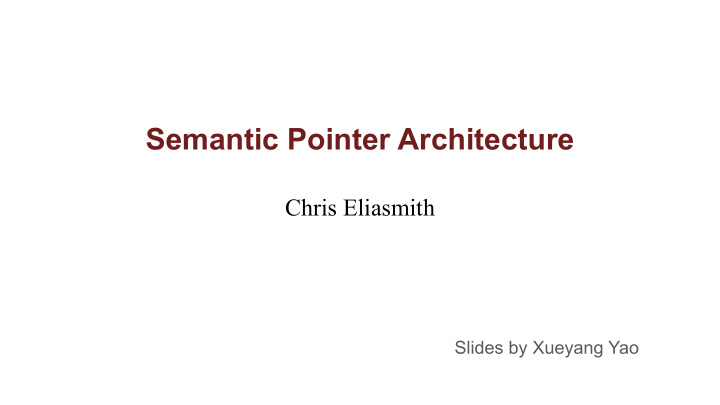



Semantic Pointer Architecture Chris Eliasmith Slides by Xueyang Yao
A task in NLP I am ... (a) sorry (b) rat (c) Luke (d) did What is the probability of the next word? p(sorry|I am) = ?
Application ● Spelling correction ● Suggestions in messengers ● Machine translation ● ...
n-gram Toy corpus: ● I am sorry to hear that. ● That ate the rat. ● I am a graduate student. ● I am not going to cook today. ● I am Luke. ● What did you do?
n-gram Toy corpus: Drawback: ● I am sorry to hear that. Data sparsity ● That ate the rat. e.g. It is hot today, could you get me a cup of iced … ● I am a graduate student. (a) water ● I am not going to cook today. (b) coke ● I am Luke. (c) table (d) rat ● What did you do? p(sorry|I am) = c(I am sorry)/c(I am ...) = 1/4
Alternative Represent each word as a real-value feature vector that captures its properties, so that words used in similar contexts will have similar feature vectors. ● Neural networks
Alternative Represent each word as a real-value feature vector that captures its properties, so that words used in similar contexts will have similar feature vectors. ● Neural networks
Semantic Pointer Hypothesis Higher-level cognitive functions in biological systems are made possible by semantic pointers. Semantic pointers are neural representations that carry partial semantic content and are composable into the representational structures necessary to support complex cognition.
Semantic Pointer Hypothesis ● Pointer vs. Feature There is simply too much information related to any particular conceptual representation to be able to actively represent and manipulate it all at the same time. Mental experiment: Think about all the things you can think of related to DOG.
Semantic Pointer Hypothesis ● Deep processing vs. Shallow processing Perceptual and verbal information are processed in distinct channels. Example: Determine whether the second word in a pair was a property of the first word: (a) “Cherry-card” (b) “Banana-monkey” Experiments show false pairings that were lexically associated took longer to process. ● Semantic pointer ○ Shallow semantics captured by semantic pointer can be thought of as “compressed” representation of complex relations that underly deep semantics. ○ Deep semantics can be dereferenced from semantic pointers.
The semantics of Perception and Action ● Dual problem Figure from How to Build a Brain by Chris Eliasmith ● Connections from different layers of the two hierarchy might exist
Summary ● Represent concept as high dimensional vectors. ● These vector representations work as pointers that point to richer information in the memory. ● The pointer itself contains partial information about the concept. ● Perception and action could be seen as reverse process. They share information from different level of representation.
Thank you!
Recommend
More recommend